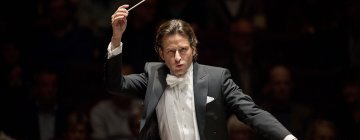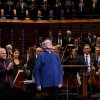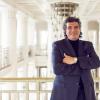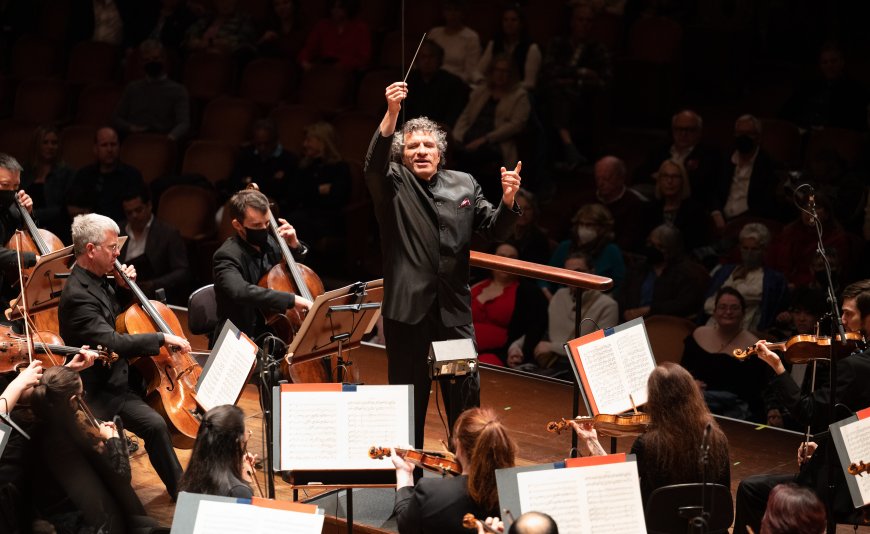
Conductor Giancarlo Guerrero’s two previous appearances with the San Francisco Symphony amply showcased his flair for colorful, dramatic music. After a two-year gap, he’s back at Davies Symphony Hall with a program of glittering orchestral showpieces.
The late Kaija Saariaho composed Asteroid 4179: Toutatis in 2005 as a complement to a Berlin Philharmonic concert featuring Gustav Holst’s The Planets. The asteroid in question is tiny and irregularly shaped, and at about four minutes in length, the music matches the object’s scale.
In addition to the astronomical theme, there are the typical Saariaho trademarks: beautiful, ingeniously layered orchestration and power that wells up over the course of the work. The piece opens with crystalline transparency, a piccolo, percussion, and celesta floating above the larger orchestra. Massed brass instruments interrupt, and after a brief climax, the orchestra dies away into silence.
It was a thoughtful start to this flashy program heard on Friday, May 2, the first of two concerts at Davies, which concluded on Saturday, May 3.
Igor Stravinsky’s great ballet score Petrushka unfolds on a completely different scale, taking some 40 minutes to tell the story of three puppets brought to life by a magician. Guerrero led a taut, exciting account of the work, performed in Stravinsky’s revised 1947 version.
One of the Costa Rican conductor’s superpowers is his ability to throw a spotlight on a piece’s structure through knife-edge timing and control of dynamics. Another is knowing when to step back and let the musicians do their thing. Tight ensemble playing was a hallmark of this Petrushka. At the same time, Guerrero gave associate principal flute Blair Francis Paponiu complete freedom in her beautifully played cadenza.
The conductor’s emphasis on sharply articulated rhythms paid off throughout the work, especially in “The Grand Carnival” section, when competing bands seemingly play in different meters. Every crescendo and decrescendo was perfectly timed. Occasionally, a section or player was drowned out in the welter of sound. John Wilson’s casual virtuosity on piano, positioned right in front of the conductor, was a highlight of the “Russian Dance,” but Guerrero covered Wilson’s playing too often in the opening tableau. The strings were sometimes obliterated by the brass. Nonetheless, this was a thrilling account of a great work.
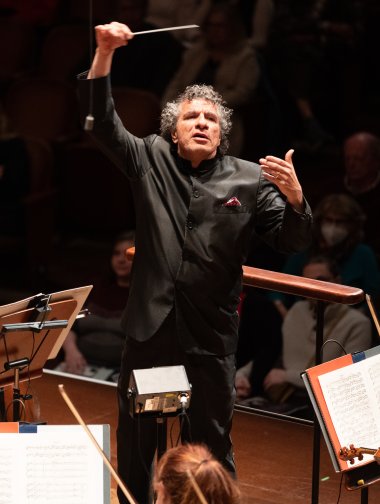
What do Stravinsky and Ottorino Respighi have in common? Both composers studied with Nikolai Rimsky-Korsakov, one of the great orchestrators of the 19th century, and both came away with enormous skill in handling huge forces.
The second half of Friday’s program was devoted to Respighi’s Fountains of Rome and Pines of Rome, flamboyant blockbusters that have to walk a fine line to avoid turning into kitsch. (This is never an issue with Stravinsky.) Guerrero performed them with a straight face, and his enormous technical skill and ear for color and dynamics made this music sound better than perhaps it fundamentally is.
The first work makes its way around Rome, picturing fountains in different locations throughout the day. The “Valle Giulia” movement, with chiming winds and a prominent celesta part, seemingly pays homage to Richard Strauss’s opera Der Rosenkavalier. Special kudos to Marc Shapiro, whose celesta playing contributed beautifully to all four works on the program, and to principal oboe Eugene Izotov and principal flute Yubeen Kim for their work in both Respighi pieces. The brass, too, played brilliantly throughout.
It’s an oddity of Pines of Rome that the splashy first movement, “The Pines of the Villa Borghese,” sounds more like an actual fountain than anything in Fountains of Rome. In “Pines Near a Catacomb,” Guerrero finely judged every climax; principal trumpet Mark Inouye was magnificent in his moody offstage solo (and also in Petrushka). Principal clarinet Carey Bell’s long-breathed, introspective solo in “The Pines of the Janiculum” was another highlight, as were the silken strings and oceanic sound Guerrero conjured.
As for the last movement, “The Pines of the Appian Way,” here Respighi generates excitement through some of the more obvious tricks in a composer’s arsenal: antiphonal brass playing from the terrace, full-orchestra chromatic slides, and an admittedly electrifying five-minute-long crescendo.
The movement is intended to evoke marching Roman legions, but it might just as well be invoking Italian Fascists or Imperial Stormtroopers. We describe, you decide.
This story was first published in Datebook in partnership with the San Francisco Chronicle.
